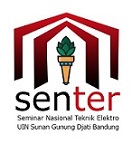Analisis Performansi Alokasi Sumber Daya Radio Berbasis Algoritma Greedy pada Sistem Komunikasi D2d Underlaying
Keywords:
Resource Block, Join Greedy, Underlaying, Device-to-DeviceAbstract
Sistem komunikasi Device-to-Device (D2D) underlaying dapat menjadi solusi dalam meningkatkan data rate dan mengurangi beban kerja eNodeB. Sistem komunikasi ini bekerja dengan membagikan resource yang dimiliki Cellular User Equipment (CUE) kepada pasangan D2D. Akan tetapi, salah satu permasalahan yang dihadapi sistem komunikasi D2D underlaying adalah masalah interferensi antara perangkat yang menggunakan resource yang sama baik arah uplink maupun downlink. Oleh karena itu, dibutuhkan suatu skema pengalokasian Resource Block (RB) sehingga RB yang dimiliki CUE dapat digunakan oleh pasangan D2D untuk melakukan komunikasi. Proses penjadwalan RB arah uplink yang dimiliki oleh CUE kepada pasangan D2D menggunakan algoritma join greedy. Proses pengalokasian RB hanya dilakukan pada sisi perangkat D2D dengan perangkat CUE yang telah terjadwal. Parameter analisis yang digunakan untuk menguji tiga algoritma tersebut adalah data rate. Dari hasil simulasi didapatkan dengan adanya pasangan D2D dalam sistem dapat meningkatkan data rate sistem sebesar 30%. dan skema join greedy mengalokasikan RB 3,059% lebih baik dari mean greedy dan 4,33% lebih baik dari skema alokasi greedy
Downloads
References
J. Chung, D. Kim and Y. Sung, "Design of Amplify-and-Forward Helper Stations for Cellular Networks with Device-to-Device Links", The Journal of Korean Institute of Communications and Information Sciences, vol. 41, no. 5, pp. 539-545, 2016.
O. Nwamadi, X. Zhu, and A. K. Nandi, “Enhanced Greedy Algorithm Based Dynamic Subcarrier Allocation for Single Carrier FDMA Systems”, 2009 IEEE Wireless Communications and Networking Conference. IEEE, 2009, pp. 1–6.
O. Nwamadi, X. Zhu and A. Nandi, "Multi-criteria Ranking Based Greedy Algorithm for Physical Resource Block Allocation in Multi-carrier Wireless Communication Systems", Signal Processing, vol. 92, no. 11, pp. 2706-2717, 2012.
M. Islam, A. Taha, S. Akl and S. Choudhury, "A Two-phase Auction-based Fair Resource Allocation for Underlaying D2D Communications", 2016 IEEE International Conference on Communications (ICC), 2016.
S. Kang, J. Kim and J. Kim, "Resource Allocation with LBS Information for Cellular Based D2D Communication Networks", 2016 International Conference on Information and Communication Technology Convergence (ICTC), 2016.
H. Zhang, T. Wang, L. Song and Z. Han, "Graph-based Resource Allocation for D2D Communications Underlaying Cellular Networks", 2013 IEEE/CIC International Conference on Communications in China - Workshops (CIC/ICCC), 2013.
Q. Chen, S. Zhao and S. Shao, "QoS-based Resource Allocation Scheme for Device-toDevice (D2D) Communication Underlaying Cellular Network in Uplink", 2013 IEEE International Conference on Signal Processing, Communication and Computing (ICSPCC 2013), 2013.
X. Song, X. Han, Y. Ni, L. Dong and L. Qin, "Joint Uplink and Downlink Resource Allocation for D2D Communications System", Future Internet, vol. 11, no. 1, p. 12, 2019.
V. S. W. Prabowo, A. Fahmi, N. M. Adriansyah, and N. Andini, “Energy Efficient Resources Allocations for Wireless Communication Systems.” Jurnal Telkomnika, vol. 17, no. 4, 2019.



